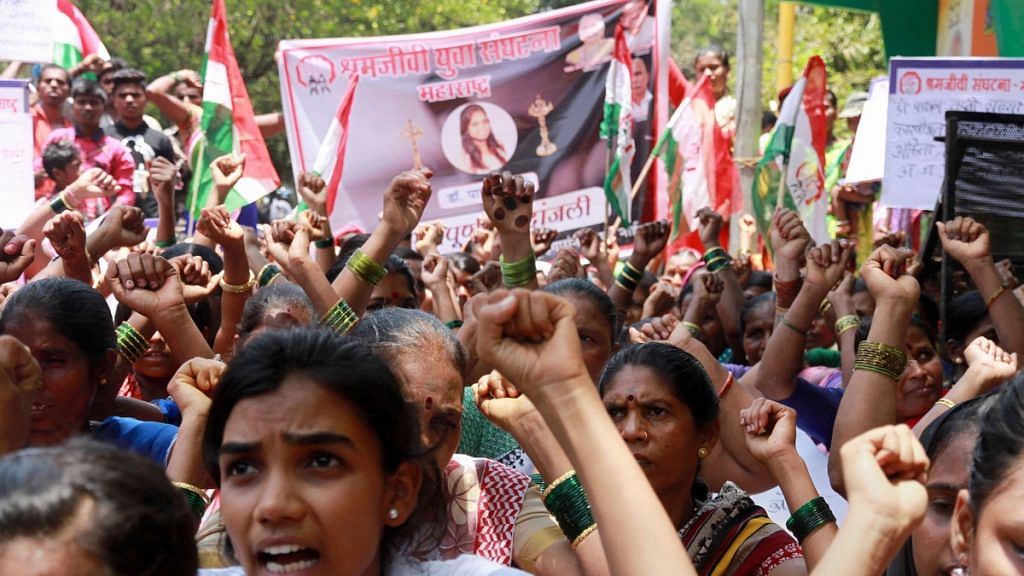Dr Payal Tadvi was an aspiring gynaecologist from the Bhil Muslim tribal community, working in the prestigious BYL Nair Hospital in Mumbai. Tadvi reaching the postgraduate course was in itself an example of the success story of India’s reservation policy enshrined in the Constitution and followed by successive governments. But this happy story came to a tragic end.
Payal Tadvi committed suicide after facing casteist slurs and harassment, according to media reports. She was stopped from conducting an operation by three of her colleagues, all of them upper castes. All three accused have now been arrested.
This is not an isolated incident where the perpetrators of caste atrocity were upper caste women. This brings us to the question: Are all women equal? All women are victims of patriarchy and should have equal access to the affirmative action policies of the state.
Also read: Are Dalit women less or more mobile than upper caste women in India? Jatis hold the answer
But here’s a list that feminist writer Komal Rajak, a doctoral fellow at Delhi University, recently compiled:
-A few days back, in Gujarat, when a Dalit marriage procession was passing through a colony of Patidars, the women residents blocked the road and started singing bhajans and even performed a yagna. This was their tactic to halt the baraat because stopping it directly would have invoked the provisions of the SC/ST Prevention of Atrocities Act. In this case, the upper caste women prioritised their caste identity over their identity as citizens.
-In the brutal Khairlanji murder incident, the non-Dalit women of the perpetrators’ families dragged out and stripped Surekha and Priyanka Bhotmange, who were later allegedly raped and murdered by several men. Here the women were co-conspirators and partners in the crime against Dalit women. They were rape enablers. Their identity as women was subservient to their identity as upper castes.
-When Twitter CEO Jack Dorsey held the ‘Smash Brahmanical Patriarchy’ placard, many of those who opposed this act were upper caste women like Smita Barooah and Advaita Kala. They saw it as an act of ‘hate speech’ against their caste. That placard was never meant to target any community and those women who opposed it were themselves victims of Brahmanical patriarchy.
-In 2016, when BJP leader Dayashankar Singh hurled sexist abuses against BSP chief Mayawati, it was his wife Swati Singh who stood by him and defended him.
-During the #MeToo movement, when Raya Sarkar produced a list of sexual harassers in the academic community, most of them were coincidently from the upper caste background. Indian academia is dominated by upper castes anyway. A statement was released by Kafila distancing the feminist movement from the list. Many of the signatories in that statement were women academicians and vocal feminists, but they preferred to stand up for the male academics of their own castes. They too were upper caste women.
-Over two decades ago, the Women’s Reservation Bill was opposed by politicians like Sharad Yadav who said there should be sub-reservation for OBC and Dalit women too. At that time, women activists outside the House had angrily countered saying women are one and cannot be divided along caste lines.
Also read: Why Dimple Yadav touching Mayawati’s feet still riles upper caste Indians
The Indian feminist movement has largely been led by upper caste women, who speak on behalf of Dalit women. But women’s organisations have rarely given them leadership positions.
This is not unique to India. In the United States and Canada, the women’s movement was largely White. When women of colour spoke against this hierarchy – with slogans like ‘nobody’s free until everybody’s free’ and ‘feminism is for everybody’ – they too were accused of dividing women and hurting the movement.
Being a woman is in itself not sufficient enough to help them transcend their other identities. Caste and race can and do override gender identity. When gender is not wired into the consciousness, the woman may act against the interest of ‘other’ women.
That is the genesis of the whole debate on intersectionality that dominated third wave feminism. In the US, the issue of race was (and still is) very prominent. The difference in the lived experience of a Black woman from that of a white Caucasian woman was/is so startling that it overwhelmed the simplistic and superficial idea of gender-sameness.
Also read: Why India’s politicians get away with casteist slurs and abuses on Dalit leaders
It’s time for Indian feminists, especially those who belong to the upper strata of society, to accept that though all of them suffer patriarchy, all Indian women are not the same and their level of deprivation is also not the same. Accepting this reality will not break the unity of women, as feared by some feminists. Rather it will fortify the idea of the differential principle, which should form the core of distributive justice.
If India passes the Women’s Reservation Bill, without any sub-quota, the benefits will mostly be cornered by upper caste women, because the lower caste women lack social and cultural capital. The idea of sub-quota for lower caste women should not be debunked just because it was proposed by Sharad Yadav.
The author is a senior journalist. Views are personal.
